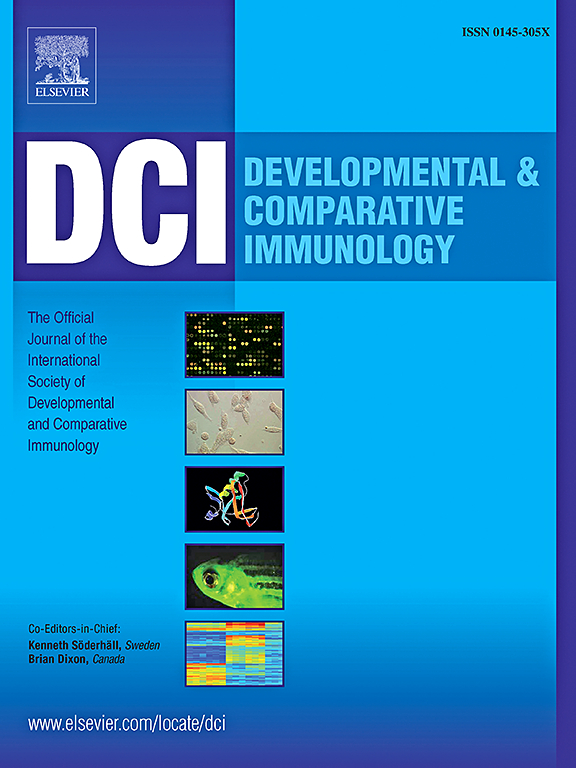Dynamic alterations in T-lymphocyte subsets assessed by flow cytometry in chickens following exposure to infectious bursal disease virus: A systematic review
IF 2.7
3区 农林科学
Q1 FISHERIES
引用次数: 0
Abstract
Infectious bursal disease virus (IBDV) is a significant pathogen in poultry, causing acute immunosuppressive disease in young chickens. While B-lymphocyte involvement in IBDV pathogenesis is known, the role of T-cells is incompletely understood. This systematic review presents the alterations in chicken T-lymphocyte subsets after IBDV exposure, assessed by flow cytometry analysis. Four databases were queried for identifying eligible studies focused on experimental infections measuring T-lymphocyte changes in the bursa of Fabricius, spleen, thymus, and peripheral blood mononuclear cells. Of 488 studies found, 25 met the pre-established criteria and were included in the qualitative synthesis of results. Most studies analysed T-lymphocyte responses during the acute phase of IBDV infection, primarily focusing on CD4+ and CD8+ T-cells. Other subsets, such as γδ T-cells and double-positive CD4+CD8+ T-cells, were less frequently investigated. An increase in T-lymphocytes was noted in the bursa of Fabricius, suggesting their active role in viral clearance. In the spleen, CD4+ T-cells commonly increased, while CD8+ responses varied among studies. Increased levels in T-cells were also noted during the chronic infection in the bursa of Fabricius, possibly due to persistent viral antigens. Overall, variations in flow cytometry methods and T-cell output reporting were noted among studies.
Based on the data collected, further investigation into diverse T-cell subpopulations beyond CD4+ and CD8+ is needed, as well as the standardization of flow cytometry assays in chickens.
通过流式细胞术评估鸡暴露于传染性法氏囊病病毒后T淋巴细胞亚群的动态变化:系统综述。
传染性法氏囊病病毒(IBDV)是家禽的一种重要病原体,可导致幼鸡急性免疫抑制性疾病。虽然已知 B 淋巴细胞参与了 IBDV 的发病过程,但对 T 细胞的作用还不完全了解。本系统综述通过流式细胞术分析评估了鸡暴露于 IBDV 后 T 淋巴细胞亚群的变化。我们查询了四个数据库,以确定符合条件的研究,这些研究侧重于测量法氏囊、脾脏、胸腺和外周血单核细胞中 T 淋巴细胞的变化。在找到的 488 项研究中,有 25 项符合预先设定的标准,并纳入了定性结果综述。大多数研究分析了 IBDV 感染急性期的 T 淋巴细胞反应,主要侧重于 CD4+ 和 CD8+ T 细胞。对其他亚群,如 γδ T 细胞和 CD4+CD8+ 双阳性 T 细胞的研究较少。法氏囊中的 T 淋巴细胞有所增加,表明它们在清除病毒方面发挥了积极作用。在脾脏,CD4+ T 细胞普遍增加,而 CD8+ 的反应则因研究而异。在法氏囊慢性感染期间,T 细胞水平也有所提高,这可能是由于病毒抗原的持续存在。总体而言,不同研究的流式细胞术方法和 T 细胞输出报告存在差异。根据收集到的数据,需要进一步研究 CD4+ 和 CD8+ 以外的各种 T 细胞亚群,并对鸡的流式细胞术检测方法进行标准化。
本文章由计算机程序翻译,如有差异,请以英文原文为准。
求助全文
约1分钟内获得全文
求助全文
来源期刊
CiteScore
6.20
自引率
6.90%
发文量
206
审稿时长
49 days
期刊介绍:
Developmental and Comparative Immunology (DCI) is an international journal that publishes articles describing original research in all areas of immunology, including comparative aspects of immunity and the evolution and development of the immune system. Manuscripts describing studies of immune systems in both vertebrates and invertebrates are welcome. All levels of immunological investigations are appropriate: organismal, cellular, biochemical and molecular genetics, extending to such fields as aging of the immune system, interaction between the immune and neuroendocrine system and intestinal immunity.

 求助内容:
求助内容: 应助结果提醒方式:
应助结果提醒方式:


